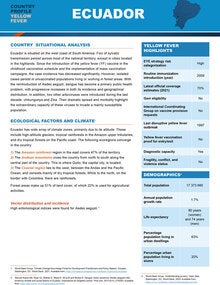Yellow fever is endemic in several Latin American countries, restricted to enzootic regions of Argentina, Bolivia (Plurinational State of), Brazil, Colombia, Ecuador, French Guyana, Guyana, Panama, Paraguay, Peru, Suriname, Trinidad and Tobago, and Venezuela (Bolivarian Republic of). Since the 1950s, urban epidemics have been controlled by a campaign to eradicate Aedes aegypti. Decades later, the mosquito re-infested most of the areas it occupied, spreading other Aedes-borne diseases, dengue, zika and chikungunya, and re-establishing the risk of urban fever epidemics. Yellow fever can be prevented by administering a vaccine. Enzootic countries introduced this vaccine into routine immunization schedules for children between 9 and 18 months of age. However, the drop in vaccination coverage results in a high risk of new outbreaks of varying magnitude. To assist decision-makers in prioritizing preventive actions against this disease, the Pan American Health Organization presents these country profiles with a concise and comprehensive selection of data from endemic countries. Each profile provides an analysis of the current country situation, ecological, and climatic factors associated with the disease, vector distribution and incidence, and key arboviral activity. It also includes a historical perspective of the epidemiology and a summary of the disease vaccination situation in the country. Each of these yellow fever country profiles expands on the situation of yellow fever in each country, including vaccination coverage, number of cases, regional information within the country for presence of the virus, past yellow fever outbreaks, epidemiology, areas with endemicity, arboviral activity, and vaccination campaigns, among other important national and regional indicators.
|

